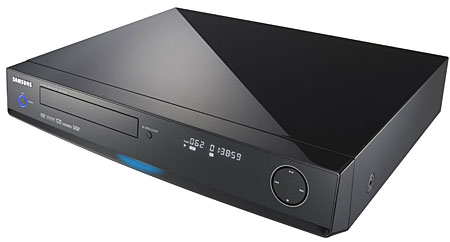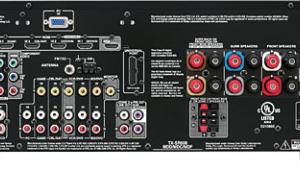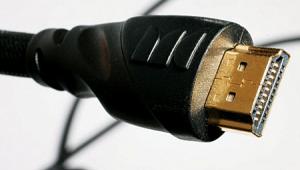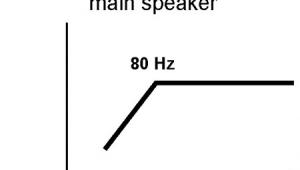High Resolution Audio and HDMI 1.3
Any recent version of HDMI can carry legacy Dolby Digital and DTS in bitstream form. But that isn't necessarily the case with the new, high-resolution formats—Dolby TrueHD and DTS-HD Master Audio. To carry those, both the player and the AV receiver or pre-pro must be equipped with HDMI version 1.3. If you have HDMI 1.3 at both ends you're good to go. Or so we thought.

Many recent AV receivers can accept multichannel PCM digital audio over earlier versions of HDMI. Most HDMI-equipped players can convert standard DD and DTS to multichannel PCM, and most (but not all) players can do the same for Dolby TrueHD.
Decoding any form of Dolby TrueHD or DTS-HD MA into PCM is a completely digital operation—a manipulation of bits. It's a fact that audiophiles have long been skeptical of digital processing, particularly of things that can corrupt the digital data stream, such as jitter. Jitter interrupts the timing sequence, so that the bits do not always arrive at their destination when they should. "Bits is bits," say the digiphiles; "The right bit at the wrong time is the wrong bit," argue the phobes.
Until it's proven otherwise, we'll come down on the side that argues that the all-digital process of converting TrueHD or DTS-HD MA to multichannel PCM digital involves no sonic compromises.
But there are, despite this alternative, advantages to passing these audio formats along to the receiver in their raw "bitstream" form. The most obvious is that no HD DVD or Blu-ray player yet available will decode the full high-resolution data stream of DTS-HD Master Audio into PCM.
Due to the complexity in decoding DTS-HD MA adding this capability would add complexity and cost to new players at a time when there is enormous pressure to produce high-definition players at lower prices. It's cheaper—or at least friendlier to current marketing realities—to put this decoding in the AV receiver, where the enthusiast will pay for it without batting an eye. To make the bitstream transmission work, however, both the player and the receiver must be HDMI 1.3 compliant.
I currently have on hand two HDMI 1.3 players: the Toshiba HD-A20 (HD DVD) and the Samsung BD-P1200 (Blu-ray). Toshiba, oddly, does not claim HDMI 1.3 in their promotional materials and specifications for this player, but they have told us that it does have an HDMI 1.3 output (transmitter) chip.

Until recently, however, there have been no AV receivers equipped with HDMI 1.3, much less the ability to decode a TrueHD or DTS-HD Master Audio bitstream once received. This has restricted our ability to check out the ability of these HDMI 1.3 players to pass along the data from these sources in bitstream form.
But we have just received the new Onkyo TX-SR875, one of the first HDMI 1.3 AV receivers to hit the market. It will not only accept Dolby TrueHD and DTS-HD Master Audio over HDMI in bitstream form, but is also designed to decode both of these formats with full resolution.
If the Onkyo receives either a Dolby TrueHD or DTS-HD Master Audio bitstream at its selected HDMI input, its front panel display will read either TrueHD or HD MSTR. This indicates that the data have arrived at the Onkyo's HDMI A/V input as a native bitstream and are being decoded by the receiver.
To cut to the chase here, neither of these designations ever appeared in the front window of the Onkyo receiver with a Blu-ray disc (on the Samsung) or an HD DVD (on the Toshiba) that carried one or the other of these high-resolution audio formats.
Want To Know More?
If I set the Toshiba's audio output to Bitstream and played a TrueHD soundtrack, the receiver's front window indicated Multi Ch. This revealed that the player was converting the TrueHD soundtrack to multichannel PCM (even though it was set to Bitstream) and passing it on to the AV receiver in that form.
But the Toshiba player does decode Dolby TrueHD, internally, in full resolution, so the PCM it passes on to the receiver offers all of the sonic benefits of TrueHD. And since there are currently no HD DVDs with DTS-HD Master Audio soundtracks, the inability of the Toshiba players to decode that format and convert it to PCM is, at least for now, irrelevant.
If I set the Samsung to Bitstream and played one of the few DTS-HD Master Audio soundtracks currently available on Blu-ray (all of them, to date, from Fox), there was sound on the title menu (the menu's audio is Dolby Digital, and the Onkyo indicated DD on its front panel while the menu was on-screen). But as soon as the film started, the screen flashed the message "HDMI Audio Not Supported," the receiver's front window read "No signal," and there was no sound.
The only way I could get audio over HDMI from the Samsung with these DTS-HD Master Audio encoded Blu-ray Discs from Fox (which carry only DTS-HD Master Audio English soundtracks) was to switch the player's audio setup to "PCM." In that setting, the player converts the DTS 1.5Mbps core track (not the full high resolution DTS-HD Master Audio data) to PCM multichannel before routing it to the receiver. In that event the front panel of the Onkyo indicates "Multi Ch."
Then things got even more curious. If I started the DTS-HD Master Audio disc on the Samsung from the beginning, then changed it to PCM to get audio once the movie started to play, and then changed it back again to Bitstream, the audio would remain on, even with Bitstream mode selected. But the receiver's front panel now read ES Discrete. This indicated that the player was feeding the receiver a bitstream of the core DTS track, but not a bitstream of full DTS-HD Master Audio stream. If the latter had been true, the receiver should have indicated HD MSTR.
(The switch from Bitstream to PCM and back again described above both required stopping the disc. But I stayed in resume mode—that is, I pushed Stop only once each time—so the movie would start up again from its previous point when I pushed Play.)
When I played a Blu-ray TrueHD soundtrack with the Samsung set to Bitstream, the Onkyo receiver indicates Dolby Digital. This means that while it the Onkyo is receiving bitstream data, that data are from the core Dolby Digital 640kbps track only, not full resolution TrueHD. If the latter were true, the receiver would have indicated TrueHD on the front panel display.
The Samsung does not, in any case, decode Dolby TrueHD internally or transcode it to PCM. So setting its output to PCM offers no benefits for this format. The only way that this player could provide a full resolution TrueHD track to the receiver would be by passing along the native TrueHD bitstream through its HDMI 1.3 output. And it will not do this.
What This All Means—For Now
The conclusion about this sometimes confusing situation is that these first HDMI 1.3 players cannot pass either Dolby TrueHD or DTS-HD Master Audio to an HDMI 1.3 receiver over HDMI in full resolution bitstream form—even though this is a stated specification for HDMI 1.3. This appears to be a limitation inherent in the first HDMI transmitter 1.3 chips [a limitation that appears, in initial testing, to apply to Sony's PlayStation3 with regard to Dolby TrueHD, as well –Ed.].
Information we have received suggests that there are now new or modified chips that can do this, but we're not aware of a player currently available equipped with the new chip. That applies to the two players here, both of which were clearly designed and built months ago, well before new chips were available.














































